► McLaren 750S vs Ferrari 296 GTB
► It’s Leiters vs… Leiters, actually
► Which one is actually the best?
One man’s brilliance is in both these cars. Luckily, engineering guru and automotive boss Michael Leiters has more than enough brilliance to go around. We pit two of the man’s finest machines against each other as we go back to back in the Ferrari 296 GTB and the new McLaren 750S.
Pre-flight briefing: McLaren 750S
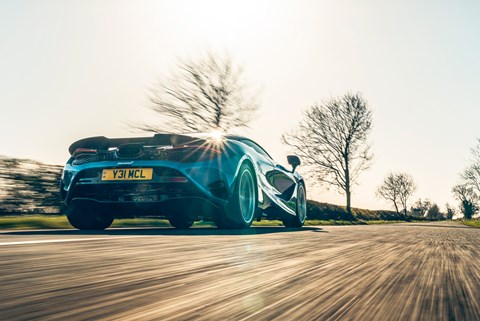
Why is it here?
Because it’s McLaren’s replacement for the excellent 720S, a car constrained by those same legacy foundations but on which McLaren has sweated the finer details.
McLaren says 30 per cent of parts are either new or changed. Power from the 4.0-litre twin-turbo V8 rises to 740bhp/590lb ft (from 710bhp/568lb ft), while a 15 per cent shorter final drive makes acceleration even more vicious (and a new centre-exit exhaust makes it a little more spine-tingling too)
Spring rates are three per cent softer at the front, four per cent stiffer at the rear, and the Proactive Chassis Control with its trick hydraulically interconnected dampers is fettled too. New lightweight alloys save a whopping 13.8kg as standard too, plus there’s quicker steering, revised brakes, all sorts.
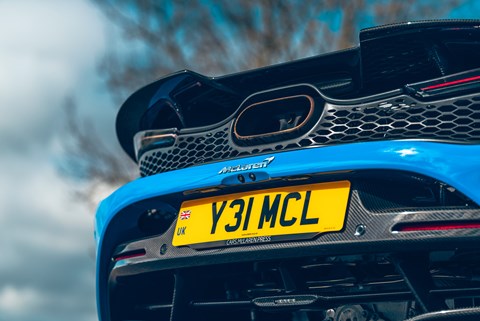
Any clever stuff?
Variable Drift Control carries over from the 720S but it’s now even more essential in helping drivers learn how to exploit a very lively car, almost like using stabilisers – essentially it gradually slackens off the stability control, from a very conservative 1 through to a virtually not there 15, all of it intuitively adjusted via the touchscreen.
Which version is this?
The 750S is a model in its own right, but this one’s got a tonne of choice extras, including over £35k of exterior carbon, a £15k Track Brake upgrade and over £6k of Super-Lightweight carbonfibre race seats. All in it lifts the £243,500 list to £343,260 as tested.
Read our McLaren 750S review here
Pre-flight briefing: Ferrari 296 GTB
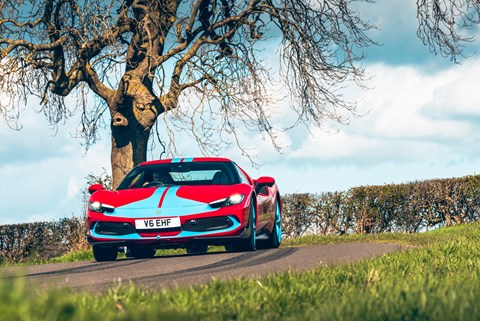
Why is it here?
It’s the class benchmark, Ferrari’s entry-level mid-engined model and a near-perfect match for the McLaren on price – £241,560 before options is a shade cheaper, though our car’s as-tested £359,227 is £16k punchier.
Total power of 819bhp is far beyond the McLaren’s 740bhp, but the 296 is also 193kg chunkier.
Any clever stuff?
Plug-in hybrid tech’s the biggie (and helps explain all that mass) – a 7.4kWh battery powers an axial-flux e-motor packaged in the eight-speed dual-clutch gearbox, adding an extra 164bhp to the 3.0-litre twin-turbo V6’s 654bhp. But it can also run on electricity alone for up to 16 miles, and at up to 84mph.
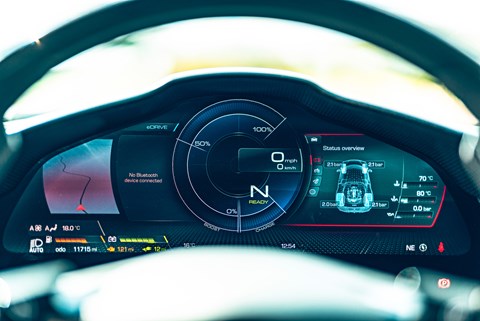
There’s also much electronic wizardry behind the 296’s highly natural feeling handling, notably the 6-way Chassis Dynamic Sensor, which monitors acceleration and speed of rotation on three axes, helping the car’s electronic brain understand the car’s dynamics and optimise its responses.
Which version is this?
It’s the coupe or GTB in Ferrari-speak, but it’s also equipped with the extended Assetto Fiorano package, an option with uprated springs and non-adjustable dampers plus a few lightweight extras including a polycarbonate engine cover and carbonfibre interior door casings. It reduces weight by over 12kg (and your bank balance by almost £26k).
Read our Ferrari 296 GTB review here
Head to head: McLaren 750S vs Ferrari 296 GTB
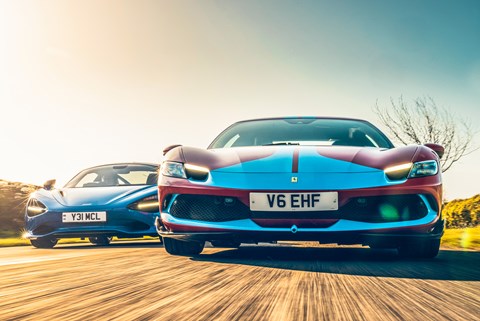
The 750S costs £243,500 before options (a similarly comparable £343,260 as tested), and hits similar metrics of 0-62mph in 2.8sec and 206mph all told. It’s just that it gets there by tossing extra fuel on the fire and cranking up the bellows. I’m over-generalising here but it’s basically true.
Yes it looks near-identical to a 720S, but 30 per cent of parts are new or altered, and this time it’s easy to relate when Leiters describes having ‘to examine every detail and really push hard for improvements to raise the bar again.’ The 720S already was exceptional.
The gist? There are Long Tail pistons and a 30bhp boost to 740bhp for the 4.0-litre V8, the seven-speed dual-clutch ’box is perked up with a fresh calibration, there’s a little more downforce and 30kg shaved off (including lightweight wheels that drop 13.8kg as standard).
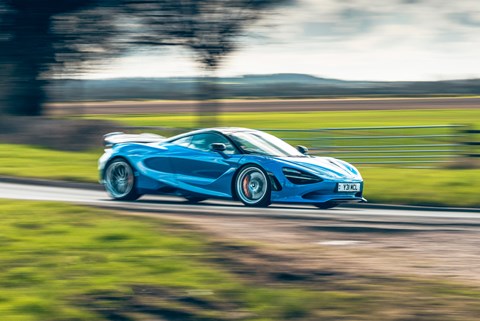
The chassis is also gently finessed – front springs are three per cent softer, the rears four per cent stiffer, the front track’s 6mm wider and McLaren’s trick Proactive Chassis Control with its hydraulically interlinked dampers benefits from a wagyu beef-like massage.
Power might fall fully 79bhp short of the Ferrari’s 819bhp, but carbonfibre construction and the lack of lithium-ion leaves it some 193kg lighter at 1277kg dry. Factor in power-to-weight and the McLaren noses ahead, plus it has a chunk more torque too (590lb ft trumps 546lb ft).
It’s a vicious thing, this 750S, the ferocity already barely contained in the 720S now compressed and amplified by a 15 per cent shorter final drive, not to mention the extra power and lower weight.
You still chew through some low-down lag to the mid-3k mark, but when it boosts, boy do those turbochargers come on with a savage kick – the aggressive Pirelli Corsa tyres on the test car struggle to deal with it all until they’re warmed through in these high single-digit temperatures, often biting and then flaring into wheelspin as the torque truly takes hold. Definitely more 765LT than 720S when it comes to power delivery.
Where the Ferrari defaults to hybrid mode and slips away quietly, the McLaren starts with a deep industrial growl, its ruminations now tickling through the carbon structure a little more pleasurably thanks to stiffer engine mounts, and a new stainless centre-exit exhaust adding extra treble to the high notes.
Let’s talk steering
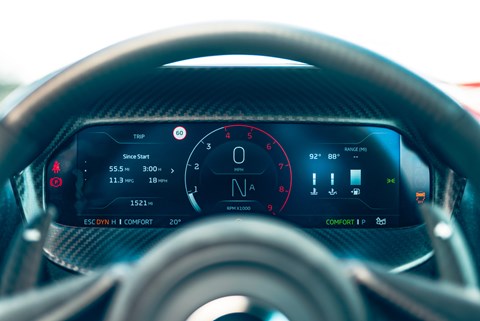
It’s the steering that first stands out. Now with a swifter rack and a new electro-hydraulic pump, it’s still blessed with gorgeous detail but emerges palpably heavier. For me it’s just a different flavour to the 720S, not actually better, but CAR’s head of video James Dennison finds it a retrograde step, ‘as though a layer of unwelcome heft and interference has been added’.
We both like the improved brakes, which bite with more conviction, partly thanks to our car’s Senna-spec upgrade with monobloc calipers and carbon-ceramic discs that take longer to form than most geologic eras.
All in, there’s a slightly more physical, direct sort of feel to the 750S right off the bat, like it’s looking you in the eye and squeezing your hand more confidently than its predecessor. Thankfully the ride quality remains sensational as ever, buttering the road beneath while still letting information stream up through the seat and wheel.
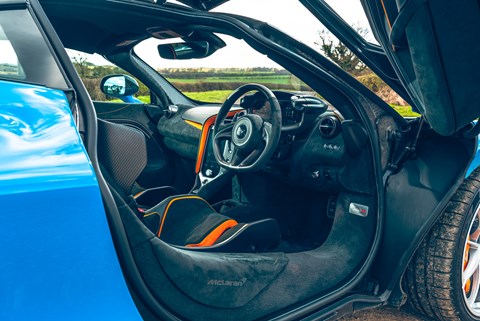
McLaren was determined to keep the astonishing chassis compliance of the 720S in its Comfort setting, while upping the ante in Sport and Track modes – something apparently managed by playing with the dampers’ pre-charge on Proactive Chassis Control.
Perhaps those more aggressive settings come into their own on the track or a really smooth road, but here – good surface, some primary undulations – Comfort is the ticket, with its more generous rebound travel giving the 750S a sweeter flow, not to mention the rear rubber more chance of biting the surface.
I leave the powertrain in Sport, though – it’s here that McLaren has added most drama with ignition-cut gear shifts, various pops and crackles and some nicely judged fizz.
And on the limit?
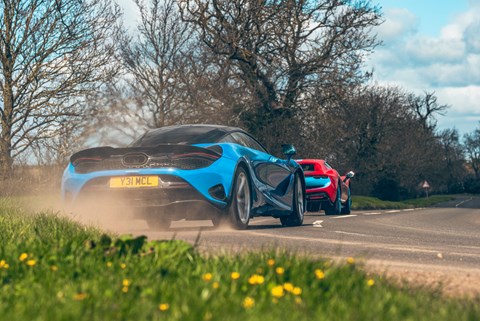
What a car to hustle. The way the 750S just glides into the apex, feel flooding back at you, steering loading up as you lean into that mid-corner balance and body control is just sublime. The uprated brakes bite more crisply, the downshifts click in with more aggression right up to the 8500rpm rev limit – my two biggest ‘must try harder’ marks for the 720S – and once you ease into it, the handling is actually more benign and delicate than those thuggish early impressions suggest.
Variable Drift Control plays a big part in allowing you to experiment with all that, so you can push up against the limits and build confidence without having to take such a leap into the unknown.
The 750S does require a certain finesse to coax the best from it, though, as JD elaborates: ‘If you’re on-throttle or coasting, the front end is a little vague, so to get the best turn-in and feel from the steering, you need to trail the brakes and get some weight over the nose. At first I found it harder to build up a rhythm and easier to get understeer than I did in the Ferrari.’
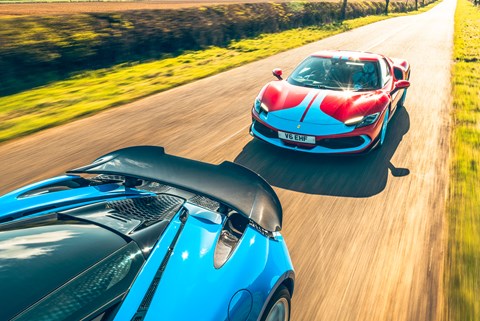
String it all together, though, get those tyres up to temps and you can monster more of that performance than perhaps seemed initially sensible. Love it.
Plus the 750S does the daily thing no bother – the compliance, visibility and this car’s super-snappy nose-lift are key to that, as are stability systems that keep you out of trouble. It is not some kind of brute. But if you think supercars are too sanitised and crave more of a challenge, something to really make your heart spike when the boost kicks, this is it.
Back to the 296
The Ferrari has a more complex character due to its more complex technical make up, but it is no more difficult to just jump in and enjoy. JD drove it up to East Anglia from London and marvelled at the versatility. ‘So easy to drive around town and on the motorway,’ he enthuses. ‘The whole car feels smaller than it is, even at low speeds, plus the hybrid system is flawlessly integrated.’
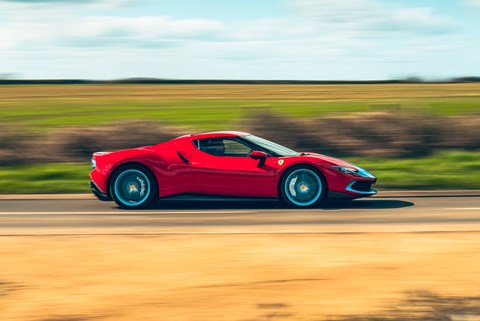
It’s true – the way the 296 slips between electric and petrol or a mix of the two is genuinely impressive. Then, when you stretch its legs on a clear bit of road, the performance on offer is simply staggering. Power delivery is smoother, more linear and more responsive than the likeably gritty and more binary McLaren engine, plus there’s a brassier, more exotic sort of noise (Ferrari engineers call it the little V12 for good reason), complemented by a cleaner snap to these gear changes.
The idea that this hybrid V6 is inferior to a V8 simply isn’t true. Despite extra power, the 296’s Michelin Pilot Sport 4S tyres claw more traction from this surface too, making the Ferrari’s performance easier to tap – even when the McLaren’s Corsas are piping hot, points out Dennison, who also notes how adept the Ferrari’s Wet mode is at babying less experienced drivers ‘without being a fun sponge’.
All that hybrid stuff does add weight, of course, but even tossing this car about, the fact that the 296 weighs any extra completely slips my mind. A big part of that is the low centre of gravity courtesy of the 120º V6. But it’s also in a wheelbase some 50mm shorter than an F8 Tributo’s, which makes electric steering that’s just as pacey as before feel even punchier (though the feel is far more synthetic than the McLaren’s).
Add in brake-by-wire stoppers blessed with a much firmer bite than the McLaren’s, a front end that slices into corners more cleanly… Wow.
JD jumps out grinning. ‘The Ferrari feels so much lighter than the spec suggests,’ he says. ‘It’s as though it’s being steered from the middle – I’ve never felt anything quite like it –and the brakes are phenomenal. They’ve got great feel, and their incredible power again adds to that sense of lightness.’
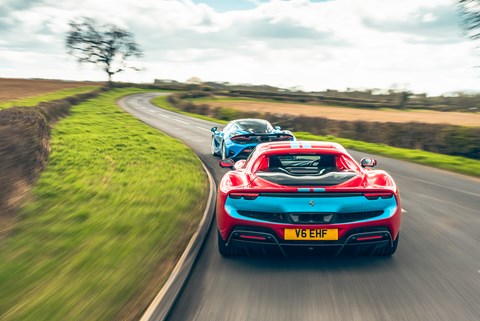
Even the ride’s peachy on this optional Assetto Fiorano set-up, which adds uprated springs and fixed-rate dampers plus some feathery trinkets. Last time I drove this exact car in the Peak District, I thought it bobbled about a bit too much on minor roads, but on these sweeping B-roads, it’s sensational.
The rear of the car feels particularly well supported on turn-in, leaving the measured body roll over the front axle as a little bellwether that you’re nearing the limit. Lean into that off-throttle and the front bites, the 296 pivots and then it’s entirely up to you how heavily you lean into the throttle.
It’s a spell-binding drive, but that McLaren is always there, agitating in the Ferrari’s rear-view mirror, making a case for itself with its gnarlier attitude and abundance of feel. Tough call, this…
McLaren 750S vs Ferrari 296 GTB: the final reckoning
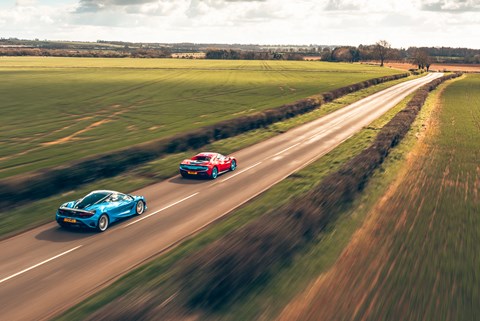
The Ferrari has a greater stretch, from its ability to operate on nothing but electricity, to the greater dexterity of a chassis that scythes and dances over the landscape, somehow finding traction the McLaren can’t, yet also bleeding more benignly into oversteer than its boosty British rival. It is the easier car to use on a more regular basis, and arguably the more satisfying and intuitive machine to push to its limits.
Part of that magic lies in the polish of its powertrain, which manages to integrate hybrid technology so seamlessly that from behind the wheel you’re barely aware it’s there at all, and brims with a level of response and linearity that makes the McLaren feel thuggish (though there’s appeal in that too).
But it’s also in the way the Ferrari blends in chassis-dynamics software that makes the 296 so biddable while also feeling entirely natural. And how it’s punchy steering and shorter wheelbase make you question whether it’s actually any heavier than the McLaren at all.
It might be the more synthetic-feeling supercar, but it is also the sharper, more precise and more reactive driving tool. On the practical side, it is also more frugal (even very wealthy people tire of topping tanks – though for the record the Ferrari did get a longer motorway run to achieve its tested 15.8mpg to the McLaren’s sub-10mpg). The Ferrari also benefits from a four-year warranty and seven-year servicing to McLaren’s three of each as standard.
The McLaren 750S is a triumph and runs the Italian close but it’s the Ferrari 296 GTB we recommend you put in the garage. Especially if you can grab one of those tempting used deals.
McLaren 750S vs Ferrari 296 GTB: verdict
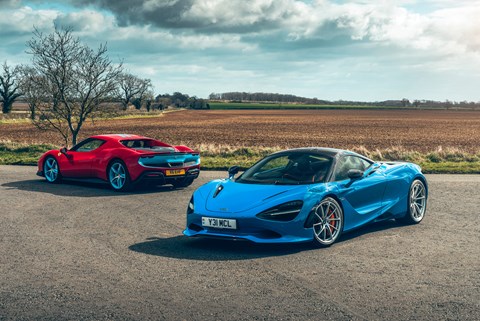
First place
Ferrari 296 GTB
Technically complex but sublime, whether in e-mode or at 8500rpm with the tyres on fire. A proper Ferrari.
Second place
McLaren 750S
Gritty authenticity meets boosty intimidation, yet compliant and useable too. Epic.